
The Manual of Counter-Terrorism
A look at the business plan of terror
Mumbai and Oslo are two very different cities. Apart from being the financial centre and the international face of their respective countries, they have little in common. Mumbai is a city of nearly 20 million people, where billionaires vie with some of the world’s poorest people for potholed road space. The Norwegian capital is a tiny city with less than one-tenth the people in Mumbai, low-rise buildings and world-class infrastructure where most places can be reached on a bicycle.
More starkly, Mumbai lives with terror every day. In the past two decades, it has lost at least 726 lives to bomb blasts and shoot-outs. Oslo is an incredibly safe city where just one life was lost to terrorism in four decades.
But this July, the two cities were united in grief. Even before the wounds of the November 26, 2008, attacks could heal, home-grown terrorists snuffed out 23 lives in three bomb attacks in some of Mumbai’s most crowded places. Within days, Norway was shaken by the rampage of a mad man whose twin attacks killed 91 people.
Suddenly, the world seems more dangerous than ever before. Will this ever stop? Is there no place safe from terror anymore? How did all the world’s greatest armies and sophisticated police forces fail to stop the maniacs? Where did all the trillions of dollars earmarked for security go?
And finally, have we lost the war on terror?
The answers lie somewhere in the collective experience of the global society from the Americas to Europe to Asia, as we endure terror attacks each year. Surprisingly, they are not where we currently look for them.
Just as terrorism is a global phenomenon, the forces that lead to its rise and fall also work across boundaries. It is possible not only to codify these ‘laws of physics’ that define the world of terror, but also use them to predict and prevent future attacks.
Strategic Foresight Group (SFG), a Mumbai-based think tank I head, has sifted through data on virtually every terrorist group in the world and studied them for common patterns, motives and strategies.
Our findings have demolished some of the common myths about terrorism that largely dictate not only the response of the common people but also the often fruitless counter-terrorism measures of nations. In place of these old shibboleths, our research has thrown up at least 10 edicts that govern the way terrorism really operates, irrespective of its labels.
An understanding of these fundamental laws is the first step to ending terrorism.
Statutory Warning: Reading this essay any further could be injurious to your bigotry. Proceed only if you can handle the truth.
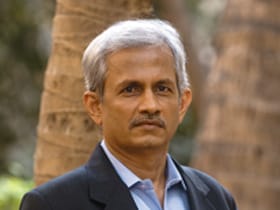
Sundeep Waslekar is the president of Strategic Foresight Group (SFG), a think tank that advises governments and institutions around the world. Terrorism is one of the five critical global challenges studied by SFG. Waslekar’s team has studied every terrorist group and its patterns of attacks across the world.
SFG helped organise a series of roundtable meetings since 2004 between Western and Islamic nations in collaboration with the League of Arab States and the European Parliament. Waslekar also serves as a resource person for premier defence colleges in India.
Edict 1: Terrorism is a game for power. Religion and ideology are just pawns on the board.
Take this quick counter-terrorism quiz:
Al-Qaeda is an Islamic terrorist organisation
True False
Prabhakaran was a champion of the Tamil cause
True False
Naxals believe in Maoism
True False
The answers are obvious, right? Or are they? Did you mark ‘true’ for any of the questions? If you did, you have just failed the basic counter-terrorism test.
Most common people, and even governments, go after religions and ideologies as being the cause of terrorism. Little do they realise that they are falling into the trap set by terrorists. For vested interests out to create trouble, religion or ideology is just a tool to be used and thrown.
The sponsors of terrorism need a glue to bind the demand and supply together. Faith is an easy vehicle to achieve this because people are emotionally aroused by it. When it is no longer useful, the masters will throw it away and move to another ideology.
Take Al-Qaeda. Early in his career, Osama bin Laden was open to negotiating with everybody from the Americans to the Afghans to the Pakistanis. He was in the marketplace for terror and anybody could have struck a deal with him.
It so happened that the Americans and Pakistanis propped him up to help Afghan refugees take over Afghanistan. It was simply a power game and Islam had no role in it. But when Osama wanted to mobilise foot soldiers, he needed a motivating force. Others had already mobilised refugees on ethnic or secular grounds. Osama chose religion to be different from them.
That was why Osama created the Islamic International Front in 1996. It didn’t start with religion. It started with the intention of taking over power.
In fact, the role of religion as an excuse for terrorism is overrated. Of the 191 terrorist groups that have been active in the recent past, only a fourth claim religious connections.
In the case of LTTE, Prabhakaran’s Tamil nationalism was a very convenient nationalism. It wasn’t an ideology that made him truly believe in Tamil welfare. Just as he was involved in killing Sinhalas, he was also involved in killing Tamil leaders who believed in devolution instead of complete separation. He also killed Tamil boys who did not join the LTTE.
With regard to Naxalites in India, New People’s Army in the Philippines, Revolutionary Armed Forces of Colombia (FARC), it was their own brand of economic ideology that came handy. They often worked with marginalised sections of society where they found that the promise of a better tomorrow worked better than ideology. But we have also seen these groups engaging in activities that are quite contrary to these ideologies.
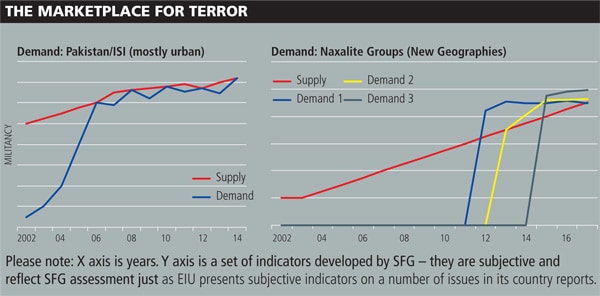
Edict 2: More security doesn’t mean more secure
In the past 10 years, there have been 34 large-scale terrorist attacks involving 100 or more casualties. With the exception of the 34th attack (Norway’s), all of them were in countries that have massive security forces and spend billions of dollars to fight terrorists.
Eighteen attacks took place in Iraq, three in Pakistan, two in India (both Mumbai), two in Russia, one each in the Philippines, Indonesia, Afghanistan, Spain, Sri Lanka, Angola, Uganda and the US (September 11, 2001).
Now, let us look at the list of the safest countries in the world. They are Norway (despite the recent massacre), Sweden, Finland, Denmark, Switzerland, Costa Rica or even tiny Andorra. These countries have minimal security arrangements and small (or no) armies.
Isn’t it an irony that those who are least at risk of terror are the ones with minimal security apparatus and countries that keep expanding their security arrangements are increasingly threatened with terror?
This correlation is not a coincidence. Countries obsessed with security turn all their energies on buying weapons and sophisticated surveillance systems. It just takes a better equipped adversary to strike again.
But countries that think increased security is not the only answer to terrorism look at the big picture and work to achieve a divergence between supply and demand curves. This requires minimising social imbalances and providing efficient governance. Their security is often small but effective.
Israel is often held up as being efficient in counter-terrorism. But it is just propaganda. In reality, Israel’s record is quite abysmal. They are tough but that doesn’t mean they are successful. Despite the fact that they have put 4,000 Palestinian suspects in prison, terror attacks continue. More than 1,000 Israelis have already died. Two years ago, a public survey found that 92 percent of adult Israelis live in fear.
Edict 3: Terrorism operates like any market. Attacks happen when supply meets demand.
The market is a place that brings together the supply of some resource and the people who need to use that resource at a mutually acceptable price. In most cases, it is about vegetables or clothes or company shares. Sometimes, it is about terror attacks.
It is no coincidence that Naxalites have gained ground in those regions of India where some of its poorest and socially most backward states are. A fraction of the youth in these societies, disillusioned by the lack of development, denial of their rights and the loss of dignity, became vulnerable to terrorist influence. This supply was cleverly exploited by militant leaders who brought in the money and organisation to unleash the country’s worst internal security threat.
For every society, there is a demand curve and a supply curve. Violence takes place at the point of intersection between demand and supply (see graphic below). Governments can prevent terrorism by intervening before the point of intersection. This can be done by shifting either the demand curve or the supply curve.
On the demand side, there is always an organised interest that encourages terrorist growth. That could be a state agency like the Inter Services Agency (ISI) of Pakistan or it could be an organised criminal gang. But it is always an organised interest, not something small or frivolous.
In India, the demand-supply gap has long been breached on multiple theatres of conflict. Attacks are happening at several intersections of demand and supply. So the unfortunate truth is, irrespective of our security preparedness, awareness and sensitivity of our citizens, terrorist attacks will continue.
Once we understand these market forces, we will begin to see the solution.
Very rarely, an individual or a small group commits a terror attack without the involvement of a specific demand side. In effect, they serve as both the supply and demand. The Norway attacks and the 1995 Oklahoma City bombing are examples of such attacks. They don’t threaten long-term peace.
Recurring terror is always a function of demand and supply.
Edict 4: Terror is a business in billions of dollars, with investors, shareholders and, of course, a large staff with killer instinct
It is a balance sheet written in blood.
On the assets side is a media empire with at least five popular publications and 150 schools, hides and skins factories and foundries. On the liabilities side is a steady stream of donations, grants from ISI and profit carried forward from extortion. The land bank includes a 140-acre campus for headquarters at Muridke in Punjab and dozens of acres given by the Pakistani government near Muzaffarabad as a reward for the 26/11 attacks. There are no tax liabilities and the profit margins hover near 80 percent.
Welcome to the international corporation called the Lashkar-e-Toiba.
Terrorism is arguably the most profitable enterprise in the world today. The big organised interests — be it the LeT or the Naxalites or HuJi (Harkat-ul-Jihad-al-Islami) in Bangladesh or the Liberation Tigers of Tamil Eelam (LTTE) — are all strong business and commercial entities.
The LeT employs a network of 10,000 commission agents in Pakistan to recruit potential terrorists. It invests millions in training the recruits. If one of its mujahideen is killed in India, the ISI gives LeT money as compensation, of which 35 percent goes to the family and 65 percent to the LeT leadership.
With this kind of cash flow, there is no incentive for the LeT to abhor terrorism. In fact, the group even started charging a levy from the milkmen of Pakistan by asking their customers to forego the change from what they pay each morning for milk. Only due to pressure from the Pakistani government did LeT stop this extortion.
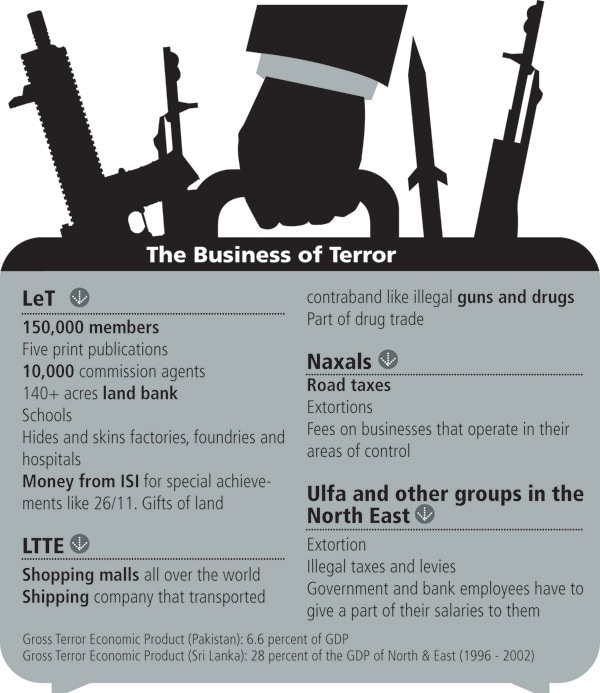
Take the LTTE in Sri Lanka. It was primarily a shipping company carrying contraband merchandise that regular shipping lines wouldn’t accept. Secondly, it was a terrorist group. Its legitimate businesses included a string of shopping malls in different parts of the world including Toronto, Canada, home to a large number of Sri Lankan Tamil diaspora. Drug dealing and gun running were some of its illegitimate pursuits.
Naxalites stick to road taxes. Businesses pay them for being allowed into their domain and trucks pay a charge to be left alone. In the North East, groups like United Liberation Front of Asom (ULFA) extort even government employees.
In Pakistan, the business of terrorism spans the ISI, various Jihadi forces, recruiters, a network of religious institutions and poppy cultivators in Afghanistan. A Strategic Foresight Group study estimated the size of this conglomeration to be Rs. 264 billion Pakistani rupees, or 6.6 percent of the country’s GDP. Call it the Gross Terror-Economic Product (GTP) but as long as economic interests of such colossal magnitude continue, terrorism is too lucrative for the concerned players to abandon and go away.
Edict 5: Step one of terror — when the long arm of development falls short
The supply of young people for terrorist purposes happens when the unholy triangle of development imbalance, democratic imbalance and dignity
imbalance is completed.
Since globalisation in the 1990s, we have created a society where some people are becoming stronger and more competitive, wealthy and capable while 800 million Indians remain on the fringes of this globalised economy.
To be able to participate in the global economy, you have to be competitive and to become competitive, you have to be competent. And those who are competent, by virtue of good education or good birth or good health, benefit and those who are not competent lose out.
The poor may be getting somewhat richer but since the rich are getting richer faster, the disparity between them is widening. The poor look at it from the viewpoint of power. For a poor woman, progress is not measured by the fact that she now has two square meals a day compared to one square meal earlier. She finds it a notional loss that somebody else is much better off. It is not only an economic comparison, it is also social. Globalisation creates winners and losers.
There is imbalance in the cities too. People who are losing out in this economic race have begun to support extremist movements. One can’t find computer engineers or investment bankers or exporters supporting such chauvinism. The support comes from people who have less competitive education (such as a B.Com degree). In fact, even a vegetable vendor with a thriving business wouldn’t support extremism. He would want to be friends with everyone and expand his business.
Our middle-level education perpetuates this inequity. Take the labour laws. It is illegal to employ children below 14. What is 14? It is the age of the 7th standard student who has failed once and is wondering what to do next. This is common in rural India because of the quality of education there. The boy will soon be sucked into the unskilled workforce.
One caveat: Just because there is development imbalance in a society, people will not rush to support terrorism. It requires a few other fatal factors to come together.
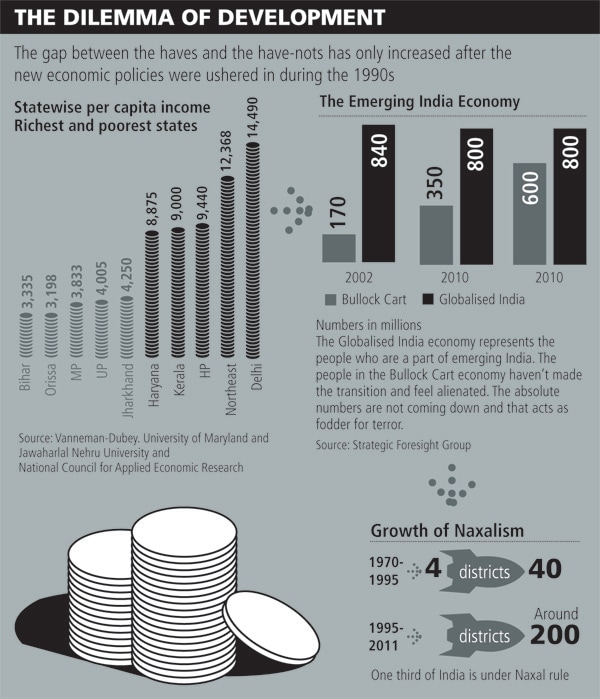
Edict 6: Step two of terror — when democracy falters
We have a democracy. We have elections. But our democratic system is owned by a few sections of society. Dynasties flourish. It is becoming more and more difficult for millions to have a say in this system.
The kind of governance structure we have evolved only gives attention to globalised India and ignores the India on the periphery. This is not because those in the government are bad. But their thinking is all about investment and foreign talent and markets. The thinking on agricultural reforms or land reforms is far less. And that is a serious policy deficit.
And now this attitude has extended even to the movies. Now every movie is made about NRIs and how the hero goes abroad and becomes great. How on earth is a poor boy in Madhya Pradesh or Tamil Nadu going to identify with that? Even the movies are about the globalised economy.
It is when people lose hope of having a say in the current system that they turn to terrorism. In Assam, the AASU (All Assam Students Union) was a peaceful movement but later, its successor ULFA was a violent one. Even in Sri Lanka, the original movement was TULF (Tamil United Liberation Front) and that had always been democratic. The LTTE came later.
Now, the Telangana movement is democratic. The lesson from history is that people should not be allowed to lose hope in the democratic system.
Edict 7: Step three of terror — when dignity goes out of the window, the storm of terror blows in “Emaciated naked children fight over a loaf of dark bread snatched from a tired dog” — This is how Oriya poet Tapan Kumar Pradhan described Kalahandi, one of India’s most impoverished districts.
But a curious thing began happening 10 years ago. The peace-loving people of Kalahandi, who had remained hopeful of the Indian state’s ability to redress their grievances, seemed to have given up. And the region quickly became a hotbed of Naxalism.
What made them suddenly embrace terrorism as a way out?
Kalahandi is where the unholy triangle got completed a decade ago. There had been a development deficit there for long, but the arrival of big businesses looking for tribal land and a powerful state machinery trying to push industrialisation brought in the democratic and dignity deficits.
Loss of dignity is the final straw. A lot of people find they don’t have any mechanism to have any dialogue with the elite. When they approach someone, it’s not that they are brutalised or killed but they are just humiliated or ignored. And that hurts.
With all these imbalances, you are bound to have some people who are willing to offer themselves for any sort of extremism or terrorism. All of that can be managed if there is no demand. But that is not possible.
Jammu & Kashmir is a classic example where the dignity deficit has played a role in creating the supply. Kashmiris think they have been neglected, not financially but politically.
The Centre allocates huge resources to Kashmir. But the dignity deficit comes in the form of insults and harassment the people face from security forces. It is not that our security forces have engaged in human rights violations. Such reports are vastly exaggerated and the behaviour of our forces in Kashmir has been honourable. The insults come during inquiries and interrogations and leave a deep psychological scar.
The neglect also happens when Delhi changes chief ministers in a state like Jammu & Kashmir at its whim, as if the opinion of the people of the state doesn’t matter. Laws like the Armed Forces (Special Powers) Act add fuel to the fire.
Edict 8: In the unequal war against terror, the weaker adversary is us
The ISI took a conscious decision in 2001 or 2002. It decided to shift the theatre of conflict from Jammu & Kashmir to urban India. It especially began targeting Mumbai, the economic and growth centre. The major attacks against India such as the one that took place on 26/11 are plotted by the ISI in their headquarters in conjunction with the army.
The people that launch such an offensive have military capabilities. But the people that defend the cities are from the police forces. There is an asymmetry of warfare between the combination of military might and the organisation of non-state actors on the one side and a civilian police force on the other. This is one reason India will always find it difficult to combat terror because it can’t just deploy the military against terrorists. The best India can do is to send in the paramilitary force or a very sophisticated force like the Force One in Mumbai now. But their capabilities are of a very different nature than the capabilities of a military force.
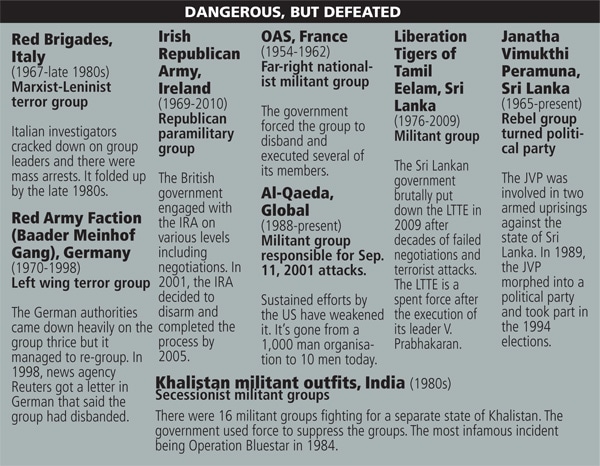
A basic problem in our approach is that we respond to the previous terror attack. We don’t know how to prepare for the next one. When someone in Europe planned to fly planes across the Atlantic and explode bombs using liquids, we banned carrying liquids on planes.
Someone attacked a hotel and we created all these security obstacles at hotels. But this is only after it was attacked, not before that. A future attack could be quite lethal. We could have a radiological attack (dirty bombs). Are we prepared for it?
We create roadblocks in areas where terror attacks have already taken place and ignore places that are potential targets. If a bomb goes off in Dadar (Mumbai), you don’t need a roadblock there. You probably need more security in the city’s naval dockyard or the Bhabha Atomic Research Centre.
We must be able to anticipate attacks in order to prevent them.
Edict 10: Future attacks can be predicted, anticipated and prevented. And terrorism put down, forever.
The LTTE. Baader Mainhof. OAS. The Red Army. The list of terrorist groups that were considered invincible at one point only to be destroyed later is
endless. And that gives us hope.
But wait. Weren’t these groups largely one-country wonders? It should have been easy for the respective governments to defeat these groups because they were working within their jurisdiction. But in India’s case, the sponsors of terrorism are largely in Pakistan. Even Naxalites and some other groups in India have formed linkages with elements in Pakistan. How can we put down terrorism when its masters are outside our jurisdiction?
Pakistan uses terrorism as a tool of war against India. This means the Indian society has to be mobilised against it. The Indian business community can play an effective role by lobbying with Western countries to reduce the flow of arms and military aid to Pakistan. This community lobbied in the case of the nuclear deal with the US and must do the same with counter terrorism.
India must make life difficult for Pakistan (but not for its people) without getting into a war. It should increase its presence in Afghanistan and achieve strategic depth there, failing which Pakistan can set up camps in Afghanistan to be used against us.
Then, there is the legal recourse. Our aim should be to have the capacity to demand the extradition of people involved with terror groups. There is already a provision to do that but it is a toothless convention under the aegis of South Asian Association for Regional Cooperation (SAARC).
Fighting terrorism can’t be left to a few officers of the government. The society must be involved in this effort. To expect that the government will be able to protect you because you pay taxes is untenable.
One lesson from the West is that making governance very effective helps in fighting terror. Especially, we have to understand that there is a close connection between corruption and crime and between crime and terrorism. All the three are linked. If India wants to eliminate terror, it has to reduce organised crime. To reduce organised crime, it is necessary to reduce corruption in government.
Finally, it is possible to anticipate future attacks using sophisticated scenario planning techniques that are used by defence ministries across the world.
(This story appears in the 12 August, 2011 issue of Forbes India. To visit our Archives, click here.)















